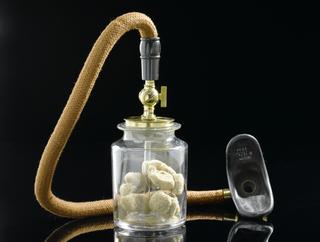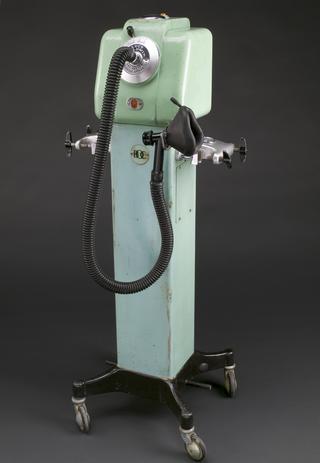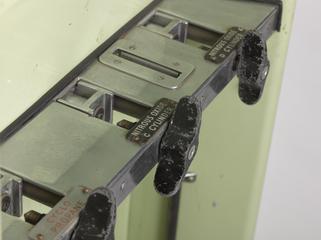Boyle's ether, nitrous oxide and oxygen anaesthetic apparatus, from design developed by Henry Edmund Gaskin Boyle to provide a continuous-flow of the gases under pressure, made by Coxeter and Son, London, 1918.
During the course of the First World War (1914-1918), the overwhelming numbers of casualties and the immediate and longer term needs of the those who were wounded prompted significant progress in a number of medical fields. At the outbreak of war in 1914, the specialist role of the anaesthetist was barely recognised but this changed as both the scale of the medical challenges and the crucial importance of pain relief and safe anaesthesia became clear.
As the war progressed, a number of individuals experimented with the machinery and chemistry of anaesthesia. In 1917 pioneering anaesthetist Henry Boyle developed a continuous-flow machine that, like this example, accurately and safely administered a mixture of oxygen, nitrous oxide and ether under pressure – rather than use an open-drop method whereby an anaesthetic is dropped directly onto gauze, from which it would be vapourised and inhaled by the patient. The fundamental characteristics of Boyle’s apparatus are still present in today’s machines.
Born in Barbados, Henry Boyle qualified at St. Bartholomew’s Hospital in London in 1901, becoming Senior Resident Administrator of Anaesthetics there in 1905. He served in the Royal Army Medical Corps during the First World War.
Details
- Category:
- Anaesthesiology
- Collection:
- Sir Henry Wellcome's Museum Collection
- Object Number:
- A630940
- Materials:
- incomplete, pine (wood), iron (cast), brass (chromium plated), glass, rubber (unidentified), leather, cotton (fibre) and cork
- type:
- anaesthetic machine
- credit:
- King, A.C.





